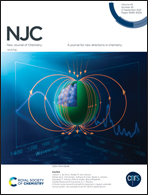Cu-nanoparticle-decorated sulfur-based polymers for highly sensitive nonenzymatic glucose detection†
Abstract
A novel copper-nanoparticle-decorated sulfur-based polymer, Cu@S-co-BIM, was designed and constructed for the chronoamperometric analysis of glucose with high sensitivity and selectivity. S-co-BIM was synthesized via inverse vulcanization as a stable conductive substrate that displayed extraordinary electrical conductivity. Copper nanoparticles were electrodeposited as the catalyst. Combining abundant active sites and the high conductivity of S-co-BIM with the excellent electrocatalytic abilities of copper nanoparticles, the Cu@S-co-BIM sensor significantly increased the selectivity and sensitivity towards glucose determination. The amperometric current linearly increased with the glucose concentration in the range of 1 μM–3.3 mM, with a detection limit of 0.32 μM. The proposed sensor exhibited high selectivity to glucose oxidation in the presence of various interfering species, such as ascorbic acid (AA), uric acid (UA), sodium chloride, fructose, xylose, and maltose. The as-prepared sensor also exhibited excellent reproducibility and long-term stability. This new method was successfully applied for the detection of glucose in serum and in commercial gluconate oral liquid with satisfactory results. In addition, the proposed composite materials might provide a new strategy for expanding the applications of sulfur-rich polymers in the field of sensing.



 Please wait while we load your content...
Please wait while we load your content...